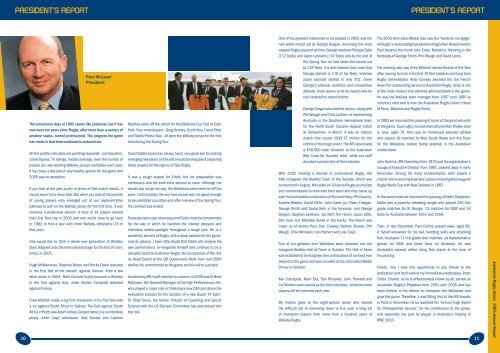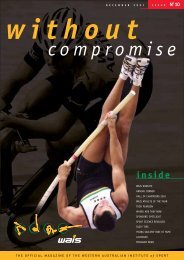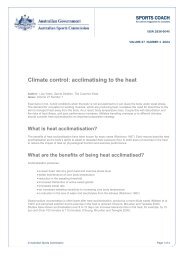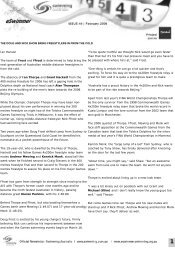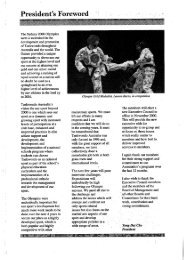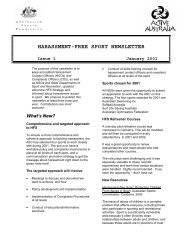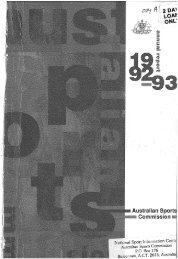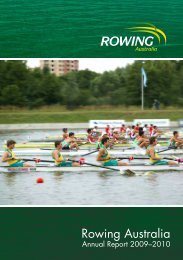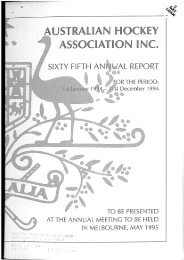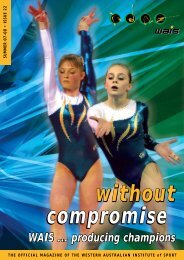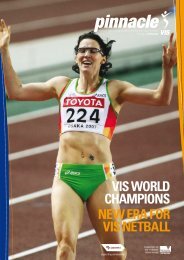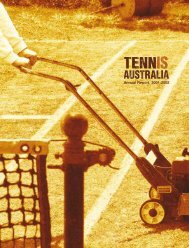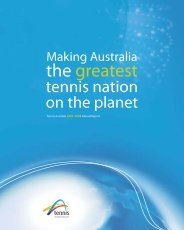community rugby - Australian Sports Commission
community rugby - Australian Sports Commission
community rugby - Australian Sports Commission
You also want an ePaper? Increase the reach of your titles
YUMPU automatically turns print PDFs into web optimized ePapers that Google loves.
PRESIDENT’S REPORT<br />
PRESIDENT’S REPORT<br />
10<br />
Paul McLean<br />
President<br />
The tumultuous days of 1995 seems like yesterday, but it has<br />
now been ten years since Rugby, after more than a century of<br />
amateur status, turned professional. The progress the game<br />
has made in that time continues to astound me.<br />
All the profile indicators are pointing skywards - participation,<br />
crowd figures, TV ratings, media coverage, even the number of<br />
people you see wearing Wallaby jerseys multiplies each year.<br />
It has been a decade of very healthy growth for the game and<br />
2005 was no exception.<br />
If you look at the year purely in terms of Test match results, it<br />
clearly wasn’t one of our best. But when you look at the number<br />
of young players who emerged out of our representative<br />
pathway to pull on the Wallaby jersey for the first time, it was<br />
certainly a productive season. A total of 14 players earned<br />
their first Test cap in 2005 and one would have to go back<br />
to 1962 to find a year with more Wallaby debutants (15 in<br />
that year).<br />
One would like to think a whole new generation of Wallaby<br />
stars stepped onto the international stage for the first of many<br />
times, in 2005.<br />
Hugh McMeniman, Stephen Moore and Rocky Elsom debuted<br />
in the first Test of the season, against Samoa. After a few<br />
false starts in 2004, Mark Gerrard finally became a Wallaby<br />
in the Test against Italy, while Alistair Campbell debuted<br />
against France.<br />
Drew Mitchell made a big first impression in his first Test with<br />
a try against South Africa in Sydney. The Test against South<br />
Africa in Perth saw Adam Ashley-Cooper debut in a numberless<br />
jersey, while Lloyd Johansson, Alex Kanaar and Lachlan<br />
MacKay came off the bench for the Bledisloe Cup Test at Eden<br />
Park. Four more players - Greg Holmes, Scott Fava, David Fitter<br />
and Tatafu Polota-Nau - all wore the Wallaby jersey for the first<br />
time during the Spring Tour.<br />
Coach Eddie Jones has always had a very good eye for picking<br />
emerging new talent and he did an outstanding job of preparing<br />
these players for the rigours of Test Rugby.<br />
It was a tough season for Eddie, but his preparation was<br />
meticulous and his work ethic second to none. Although the<br />
results did not go his way, the Wallabies were never far off the<br />
pace. Unfortunately the win-loss record was not good enough<br />
to secure Eddie’s position and after a review of the Spring Tour,<br />
his contract was ended.<br />
These decisions are never easy and Eddie must be commended<br />
for the way in which he handled the intense pressure and<br />
relentless media spotlight throughout a tough year. He is a<br />
wonderful servant of Rugby, with a deep passion for the game,<br />
and its players. I have little doubt that Eddie will analyse his<br />
own performance, re-invigorate himself and continue to be a<br />
valuable asset to <strong>Australian</strong> Rugby. His acceptance of the role<br />
as Head Coach at the QR Queensland Reds from mid-2006<br />
verifies his commitment to the game and his will to succeed.<br />
Another key ARU staff member to move on in 2005 was Dr Brett<br />
Robinson, the General Manager of the High Performance Unit,<br />
who played a major role in finalising a new CBA and drove the<br />
evaluation process for the location of a new Super 14 team.<br />
Dr Peter Davis, the former Director of Coaching and <strong>Sports</strong><br />
Science with the US Olympic Committee has now moved into<br />
the role.<br />
One of the greatest milestones to be passed in 2005 was the<br />
new world record set by George Gregan, becoming the most<br />
capped Rugby player of all time. George overtook Philippe Sella<br />
(112 Tests) and Jason Leonard (114 Tests) and by the end of<br />
the Spring Tour he had taken the record out<br />
to 118 Tests. It is with interest that I note that<br />
George started in 116 of his Tests, whereas<br />
Jason Leonard started in only 102. Given<br />
George’s physical condition and competitive<br />
attitude, there seems to be no reason why he<br />
can’t extend his record further.<br />
George Gregan also had the honour, along with<br />
Phil Waugh and Chris Latham, of representing<br />
Australia in the Southern Hemisphere team<br />
for the North-South Tsunami Appeal match<br />
at Twickenham in March. It was an historic<br />
match that raised US$3.35 million for the<br />
victims of this tragic event. The ARU also made<br />
a $50,000 cash donation to the <strong>Australian</strong><br />
Red Cross for Tsunami relief, while our staff<br />
donated a proportion of their salaries.<br />
With 2005 marking a decade of professional Rugby, the<br />
ARU instigated the Wallaby Team of the Decade, which was<br />
announced in August. We called on 30 senior Rugby journalists<br />
and commentators to nominate their team and they came up<br />
with the formidable combination of Richard Harry, Phil Kearns,<br />
Andrew Blades, David Giffin, John Eales (c), Owen Finegan,<br />
George Smith and Toutai Kefu in the forwards, and George<br />
Gregan, Stephen Larkham, Joe Roff, Tim Horan, Jason Little,<br />
Ben Tune and Matthew Burke in the backs. The bench was<br />
made up of Jeremy Paul, Dan Crowley, Nathan Sharpe, Phil<br />
Waugh, Chris Whitaker, Dan Herbert and Lote Tuqiri.<br />
Five of our greatest ever Wallabies were inducted into the<br />
inaugural Wallaby Hall of Fame in October. The Hall of Fame<br />
was established to recognise the contributions of our best ever<br />
players to the game and was unveiled at the John Eales Medal<br />
Dinner in October.<br />
Ken Catchpole, Mark Ella, Tom Richards, John Thornett and<br />
Col Windon were named as the first inductees, while two more<br />
players will be inducted each year.<br />
My thanks goes to the eight-person panel who shared<br />
the difficult job of narrowing down to five such a long list<br />
of champion players from more than a hundred years of<br />
Wallaby Rugby.<br />
The 2005 John Eales Medal also saw the “backrow mortgage”<br />
on Rugby’s most prestigious award extinguished. Hooker Jeremy<br />
Paul became the fourth John Eales’ Medallist, following in the<br />
footsteps of George Smith, Phil Waugh and David Lyons.<br />
The evening also saw Drew Mitchell named Rookie of the Year<br />
after scoring six tries in his first 10 Test matches and long-time<br />
Rugby administrator Andy Conway awarded the Joe French<br />
Award for outstanding service to <strong>Australian</strong> Rugby. Andy is one<br />
of the most modest and admired administrators in the game.<br />
He was the Wallaby team manager from 1987 until 1990 (a<br />
voluntary role) and is now the <strong>Australian</strong> Rugby Union’s Head<br />
of Tours, Matches and Rugby Policy.<br />
In 2005 we mourned the passing of some of the great servants<br />
of the game. Dual <strong>rugby</strong>/cricket international Alan Walker died<br />
in June, aged 79. Alan was an immensely talented athlete<br />
who played 10 matches for New South Wales and five Tests<br />
for the Wallabies, before being selected in the <strong>Australian</strong><br />
cricket team.<br />
John Dedrick, ARU Secretary from 1976 and the organisation’s<br />
inaugural Executive Director from 1981, passed away in early<br />
November. Among his many achievements, John played a<br />
critical role in securing Australia’s place in hosting the inaugural<br />
Rugby World Cup with New Zealand in 1987.<br />
In the same week we mourned the passing of Eddie Stapleton.<br />
Eddie was a powerful attacking winger who played 236 first<br />
grade matches for St George, 13 matches for NSW and 16<br />
Tests for Australia between 1951 and 1958.<br />
Then, in late December, Paul Collins passed away, aged 89.<br />
A flyhalf renowned for his ball handling skills and attacking<br />
flair, he played 71 first grade club matches, six representative<br />
games for NSW and three Tests for Australia. He was<br />
Australia’s second oldest living Test player at the time of<br />
his passing.<br />
Finally, may I take this opportunity to pay tribute to the<br />
dedication and hard work of my immediate predecessor, Peter<br />
Crittle. Charlie, as he is affectionately known by all, served as<br />
<strong>Australian</strong> Rugby’s President from 2001 until 2005 and has<br />
been tireless in his efforts to champion the Wallabies and<br />
grow the game. Therefore, it was fitting that at the iRB Awards<br />
in Paris in November, he be awarded the ‘Vernon Pugh Award<br />
for Distinguished Service’, for his contribution to the game,<br />
and especially the part he played in Australia’s hosting of<br />
RWC 2003.<br />
11<br />
<strong>Australian</strong> Rugby Union 2005 Annual Report


